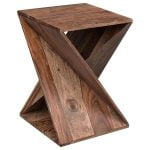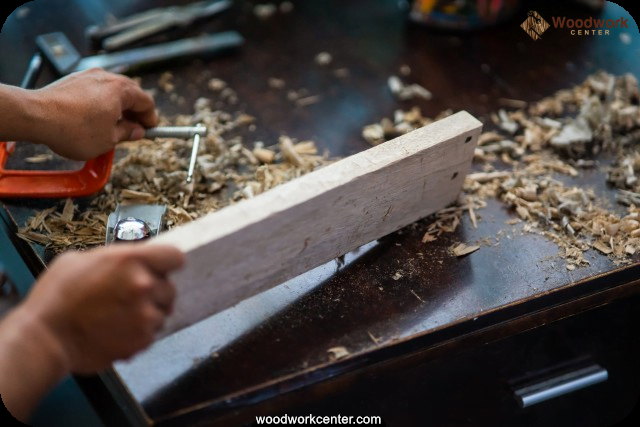Introduction
Woodworking dates back centuries and has been practiced in various cultures throughout the world, from Native Americans to classical Greek artisans. It is a highly creative and rewarding activity that has a wide range of roles in furniture making, architecture, sculpture, boat design, and more. The practice of woodworking can be incredibly therapeutic with its emphasis on both concentration and mindfulness. Working with wood also results in tangible products that can be admired and handed down over generations.
As someone starting out in woodworking, it will be important to understand the basics of tools and materials before diving into projects. Having an understanding of wood species, wood joinery techniques (including tenons, mortises, dovetails), cutting tools (wood saws, routers), sanders (flat belt or oscillating spindle), hand tools (chisels or mallets) chisels etc., will all help you become more comfortable with the craft of woodworking. Additionally becoming aware of your own abilities in terms of working smaller scale repairs will make you even more confident at taking on more complex work such as cabinetry design & construction or furniture refinishing. In addition to learning about the necessary tools for each job, there are safety practices you must observe when working with heavy materials & power driven blades/bites – gloves & goggles should always be worn as well as ensuring adequate ventilation when sanding finer dust particles from hardwoods or multiple finishes. Finally many newbies might not know about the selection criteria for lumber which goes beyond species choice & grain quality – looking at moisture contect is important because when it shifts between low/high it results in warped dimensions which could ruin your projects! All this information gives an entry point into woodworking while laying foundation for pursuing larger scale works down the road.
Essential Tools for Beginners
Having a basic toolbox for beginners is essential to have when first starting out in woodworking. It should include a hammer, saw, screwdriver set, hand saw and drill. The hammer is used to drive nails into and remove them from the wood. A saw can be used for cutting lumber, trimming edges and fastening boards together. The screwdriver will come in handy for drilling pilot holes or driving screws. A hand saw can be used for finer cuts such as cutting curves and circles out of the wood, or for rips and crosscuts. Lastly, the drill allows for precise measurements of material for accurate joinery pieces as well as drilling holes needed in your project. Once these tools are obtained you will be able to build simple but sturdy projects using traditional carpentry methods. This basic toolbox should also include other items like an awl, chisel set, sandpaper, small files and clamps to allow more detailed woodworking projects without needing expensive machinery.
Protective Gear for Safety
When it comes to woodworking, safety is a top priority for any beginner. It is important to understand the proper protective equipment to use when handling tools and materials. The most essential piece of clothing for woodworking is a heavy-duty pair of boots with steel toes. Steel toes protect your feet in the event that you drop something on your toe, or trip and fall while carrying cumbersome power tools.
Gloves are also important, as they protect hands from dangerous splinters as well as sharp edges on saw blades or chisels. Purchase a few pairs of work gloves that are both durable and non slip.
Eye protection should never be overlooked, no matter how small the job may be. Invest in a good pair of safety glasses specifically designed for woodworking projects or make sure that standard construction goggles fit comfortably over your head or glasses if needed.
A dust mask can help you stay safe from inhaling any particles created by cutting wood. A heavy-duty earplugs act like an invisible barrier between you and loud machines like circular saws and routers. They also protect from flying debris such as splinters or shavings when working with sanders or lathes. Additionally, respirators can help filter out toxic particulates created during certain jobs such as furniture refinishing workshops where powerful chemical fumes may present more serious health risks than typical dust particles.
Finally don’t forget to wear clothes which cover vulnerable areas of your body including arms, chest, legs and all other exposed skin – this includes long socks! When looking at different types of protective gear keep in mind comfort should not be sacrificed for price—safety first!
Understanding Different Types of Woods
When it comes to woodworking for beginners, understanding different types of woods and analyzing their grains and density are essential pieces of knowledge. Different kinds of woods have unique textures, grains, and densities; all of which can affect the appearance, performance, and quality of your final project.
Hardwoods such as maple, oak, walnut, cherry and other exotic species have a uniform grain pattern that is visually appealing and durable enough for heavy use. Softwoods like pine and fir have a coarse grain with wider spaces between each grain , making them suitable for low-traffic applications such as furniture frames and trim pieces. Some hardwoods also have less dense properties than softwoods, meaning they can be worked more easily with hand tools or even power tools without producing unsightly tearouts or leaving burn marks on the surface.
Knowing the difference between hardwoods and softwoods is essential so you can make informed decisions when selecting materials for your projects. With experience in woodworking, you can also learn to read wood grains so you can choose the right kind of wood to produce the desired visual effect or look. Moreover, knowing how dense various woods are will help determine how challenging the cutting process will be along with overall stability when finished!
Essential Techniques
The first essential technique to master when beginning woodworking is a joinery technique. This is the process of connecting two or more pieces of wood with adhesives, screws, nails, dowels or other mechanical fasteners. Common joinery techniques include biscuits, dados, dovetail joints, mortise and tenon and rabbet joints.
Learning how to use power tools is also important for woodworkers. Common power tools used in woodworking are routers, sanders, grinders and saws. Routers create decorative edges on pieces as well as make perfect grooves or circles in cross sections of wood. Sanders level surfaces for a ultra smooth finish and help to strip off old finishes from furniture items being re-finished. Grinders remove excess material like rust or paint off surfaces and edges while saws are used for cutting materials into different shapes and sizes. Lastly, drills create holes precisely when attached with specialized bits such as self-feed bits and spade bit sets.
Woodworking Design & Measurements
Woodworking design and measurements is essential for any beginning woodworker. Learning to calculate and measure accurately is one of the most important competencies a person wanting to become a successful hobbyist or professional carpenter can acquire. A basic understanding of mathematics, such as length, width, height, area, volume and angles will enable you to accurately plan projects such as measuring material lengths of two-by-fours or cutting board outlines.
Including along with the fundamentals of mathematics are the principles of geometry. These include comparing shapes by their perimeter, area or volume in order to create custom designs that may be necessary for certain projects. With an understanding of the basics along with practice in measuring materials can make it simpler for beginner woodworkers.
Having a reliable ruler or tape measure on hand is also key in successful woodworking design and measurements. It will allow for accurate readings when cutting materials for furniture or cabinetry building needs. For even greater accuracy, laser gauges, digital calipers and other precision instruments are useful tools to have as well. Additionally a square ruler/protractor combo should also be part of any woodworker’s toolkit if designing cabnitry or shelves that need fixtures installed at exact precision on walls and ceilings alike. Knowing how these factors work together will provide beautiful results when building furniture or creating cabinetry pieces with symmetry which requires careful consideration before building anything out of wood.
Wood Finishing Options
When it comes to wood finishing, there are many options available to beginner woodworkers. The type of finish you choose will depend on the project that is being worked on and the level of protection needed. Popular finishing options include sealing the wood with lacquer or varnish, waxing the wood, staining and painting the wood, and applying shellac.
Lacquer and varnish provide a beautiful glossy finish with superior durability. A major difference between lacquer and varnish is that lacquer forms a harder protective film which is resistant to water damage and moisture. Varnishing requires multiple coats which also helps to increase its protective qualities against dirt, dust and abrasion. Sanding between coats gives a smoother final appearance to your workpiece.
Waxing can also be used as a cosmetic finish that adds sheen and highlights any imperfections in a piece of wood. It prevents fingerprints from marring the surface but does not offer much protection from environmental elements such as UV radiation or excessive moisture damage. Wax can come in many forms such as cream or paste and natural or synthetic products are available for different applications.
Staining is often used when wanting to bring out features within the grain of certain woods or just simply darken them altogether for a deeper hue contrast within different sections of one workpiece. Stains are available either in liquid form or gel form, depending on desired results and how quickly they need to be applied. They can cover up blemishes or enhance particular areas for decorative pieces such as furniture, cabinets or other detailed works of art made out of wood.
Painting often goes hand in hand with staining where painted designs further accentuate stained portions already present in an existing piece of work such as intricate decor applied through color techniques executed with brushstrokes onto artistic wooden crafts like decorative boxes, sculptures and other masterpieces. Primers should always be applied prior to painting as this assists in achieving a smooth even finish once paint has dried onto surface material preventing smudges from visible brush marks during application procedure.
Finally if greater protection against dirt, dust buildup, fading due to age and frequent handling is needed – shellac should be considered as an option . Shellacs come in two main varieties; orange shellac which results in lighter finishes whereas de-waxed shells achieve deeper darker tones – both promising long lasting resilience along with deep luster versus other lesser known methods mentioned above offering only minor shielding against daily wear-and-tear associated with heavily used surfaces directly exposed to public interaction such as tables/counters etc..
Practical Projects & Tips
Woodworking can be an exciting and enjoyable hobby for anyone. For beginners, it’s important to have the right tools and supplies in order to get started properly. Here are some of the essentials that will help you bring your first woodworking projects to life:
• Safety Equipment – The most important pieces of equipment for any woodworker are safety glasses, work gloves, and a dust mask or respirator. When working with wood, eye protection is a must to protect against flying particles and sawdust. Work gloves also help save hands from splinters, cuts, scrapes and bruises as well as provide a secure grip on tools. Lastly, a dust mask or respirator helps keep smoke inhalation at bay on those long-term projects.
• Power Tools – An essential piece of any woodworkers toolkit is their power tools. This includes cordless drills, circular saws, orbital sanders, routers, jigsaws and reciprocating saws which all have their own special functions when crafting projects out of wood. Depending on your project’s needs one or more of these tools will make your project much easier to complete accurately while helping you save time and energy in the process.
• Hand Tools – In addition to power tools you will also need hand tools such as chisels, measuring tapes/rulers, mallets/hammers and clamps plus many more depending on the types of projects being done. While these may seem less necessary than power tools they actually play an important role in completing finish-oriented tasks like smoothing & polishing surfaces so there are no rough edges present in the final product as well as getting into small spaces where powered drills can’t reach with precision accuracy.
• Finishing Supplies – When it comes to finishing off any woodworking project you will wantto ensure that you have quality finishing supplies like stains & sealants along with sandpaper on hand so you can add a professional touch to the final product that customers would expect when buying something handmade from one given individual. These products not only help bring out natural grain patterns but also protect against moisture damage which can lead to warping over time due altering in climate conditions throughout the year or seasons changing temperatures drastically too quickly without having proper indoor storage away from general areas occupied by people (living rooms).
Conclusion
For beginner woodworkers, the right set of tools and materials can make all the difference. When starting out in woodworking, it’s important to research and identify what pieces you need before investing in them. Becoming familiar with which saws, chisels and drills are best-suited for specific tasks will help you complete projects more efficiently and with better results. Additionally, using select hardwoods such as mahogany or cedar can also improve the look and feel of your work. Lastly, woodworking is a learning process — having access to instruction manuals or attending classes is an important way to refine your skill set over time. Once you obtain these basic building blocks of success as a woodworker, you are ready to join the ranks of professional craftspeople!

Hi everyone! I’m a woodworker and blogger, and this is my woodworking blog. In my blog, I share tips and tricks for woodworkers of all skill levels, as well as project ideas that you can try yourself.





